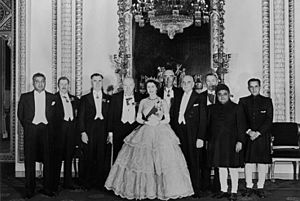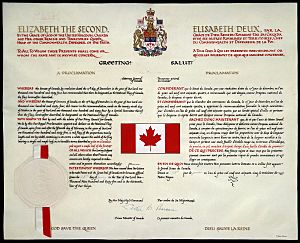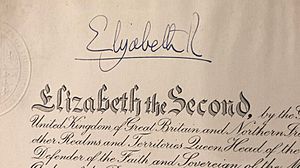Royal Style and Titles Act facts for kids
A Royal Style and Titles Act is a special law passed in a country. This law decides the official name or "title" for the king or queen of that country. This idea started in 1876 in the United Kingdom.
At first, one title was used for the monarch across the whole British Empire. But after 1931, countries that shared the same monarch decided they wanted their own unique titles. This happened especially in 1952 when Queen Elizabeth II became queen. As more countries became independent, they also passed their own laws to set their monarch's title.
Contents
How Royal Titles Changed

For a long time, the Parliament of the United Kingdom decided the monarch's title for the entire British Empire. But as countries like Canada and Australia became more important, the British government started asking their opinions.
By 1926, it was clear that the Empire was changing. Countries were becoming more independent. So, the King's title needed to show this. This led to a new law in 1927. However, this law still gave the King one title for the whole Empire.
In 1931, a very important agreement was made. It said that if the monarch's title was going to change, all the independent countries that shared the monarch had to agree.
Then, in 1949, these countries decided that each one should have its own royal title. But they also wanted some parts of the title to be similar. When Queen Elizabeth II became queen in 1952, each country passed its own Royal Style and Titles Act. They did this before her official crowning ceremony in June 1953.
Titles in Different Countries
Many countries that share the same monarch passed their own laws to define the royal title. Here are some examples:
Antigua and Barbuda
Monarchy of Antigua and Barbuda#Title
In 1981, Antigua and Barbuda passed its own Royal Titles Act. This law allowed the monarch to have a specific title for their country. From February 1982, Queen Elizabeth II's title there was: Elizabeth the Second, by the Grace of God, Queen of Antigua and Barbuda and of Her other Realms and Territories, Head of the Commonwealth.
Australia
In 1953, Australia passed its Royal Style and Titles Act. This law gave Queen Elizabeth II the title: Elizabeth the Second, by the Grace of God Queen of the United Kingdom, Australia and Her other Realms and Territories, Head of the Commonwealth, Defender of the Faith.
Later, in 1973, this law was changed. It removed the mention of the United Kingdom and the term "Defender of the Faith" from the Australian title.
Canada
Style and title of the Canadian sovereign

In 1947, Canada passed its own Royal Style and Titles Act. This removed the title "Emperor of India" from the Canadian monarch's name.
In 1953, Canada passed another law to change the royal title. On May 28, the new title for the Canadian monarch was announced. In English, it was: Elizabeth the Second, by the Grace of God of the United Kingdom, Canada, and Her other Realms and Territories, Queen, Head of the Commonwealth, Defender of the Faith. In French, it was: Elizabeth Deux, par la grâce de Dieu Reine du Royaume-Uni, du Canada, et de ses autres royaumes et territoires, Chef du Commonwealth, Défenseur de la Foi.
More recently, in April 2023, after King Charles III became monarch, a new law was proposed in Canada. This law would allow the King to issue a new title for Canada. This new title would not mention the United Kingdom or "Defender of the Faith." The proposed new title would be: Charles the Third, by the Grace of God King of Canada and His other Realms and Territories, Head of the Commonwealth. This law was approved in June 2023, but the new title has not yet been officially announced by the King.
New Zealand
After the Second World War, New Zealand showed its independence by changing the monarch's title in 1953. For the first time, the official title specifically mentioned New Zealand. This showed that the monarch was the Queen of New Zealand, not just the UK. The title became: Elizabeth II, by the Grace of God of the United Kingdom, New Zealand and Her Other Realms and Territories Queen, Head of the Commonwealth, Defender of the Faith.
Later, in 1974, another law changed the title again. The monarch's title in New Zealand became: Elizabeth the Second, by the Grace of God Queen of New Zealand and Her Other Realms and Territories, Head of the Commonwealth, Defender of the Faith.
United Kingdom
Style of the British sovereign Royal Titles Act 1876

In 1901, a law allowed the words "and of the British Dominions beyond the Seas" to be added to the monarch's title in the UK.
In 1927, another law was passed. This law was changed in 1948 to remove the words "Emperor of India" from the monarch's title in the United Kingdom. So, King George VI's title became: George VI by the Grace of God of Great Britain, Ireland and the British Dominions beyond the Seas King, Defender of the Faith.
In 1953, a new Royal Titles Act was passed for the United Kingdom. This law made sure the title was clear, especially after Ireland became a republic in 1949.
With this law, Queen Elizabeth II announced her title for the United Kingdom. It was: Elizabeth II, by the Grace of God of the United Kingdom of Great Britain and Northern Ireland and of Her other Realms and Territories Queen, Head of the Commonwealth, Defender of the Faith. This title was also set in Latin for the first time.
Images for kids
See also


